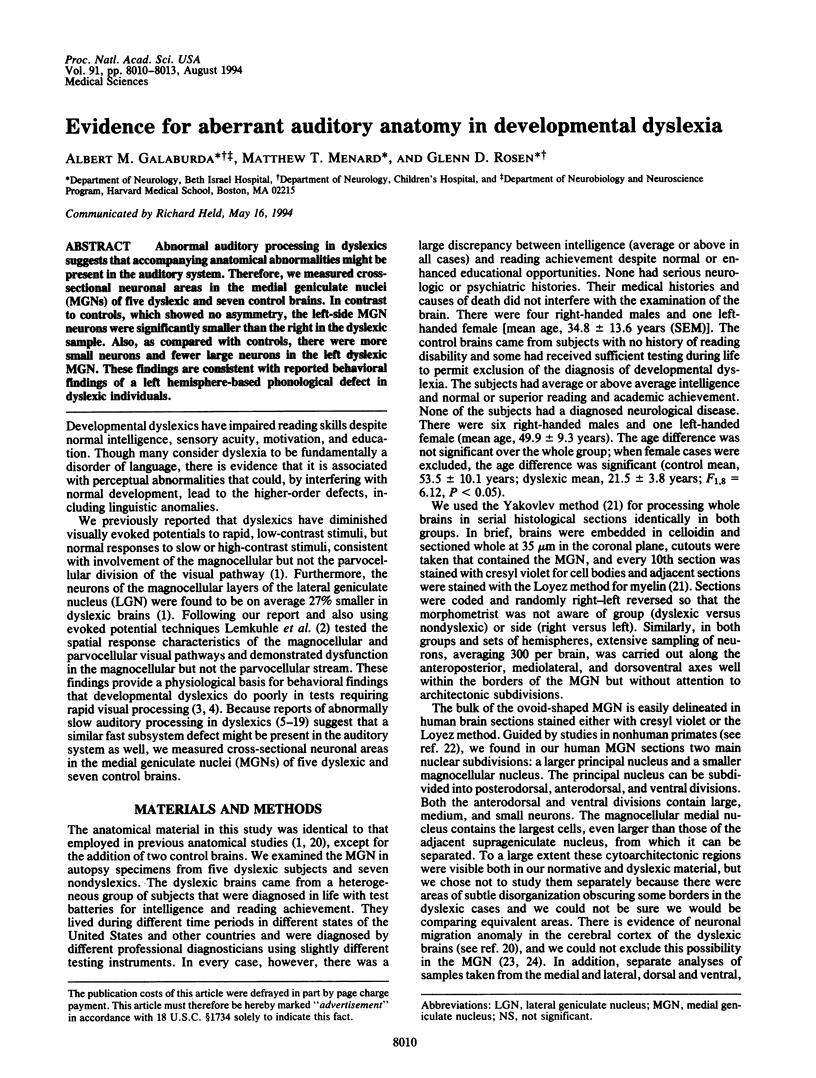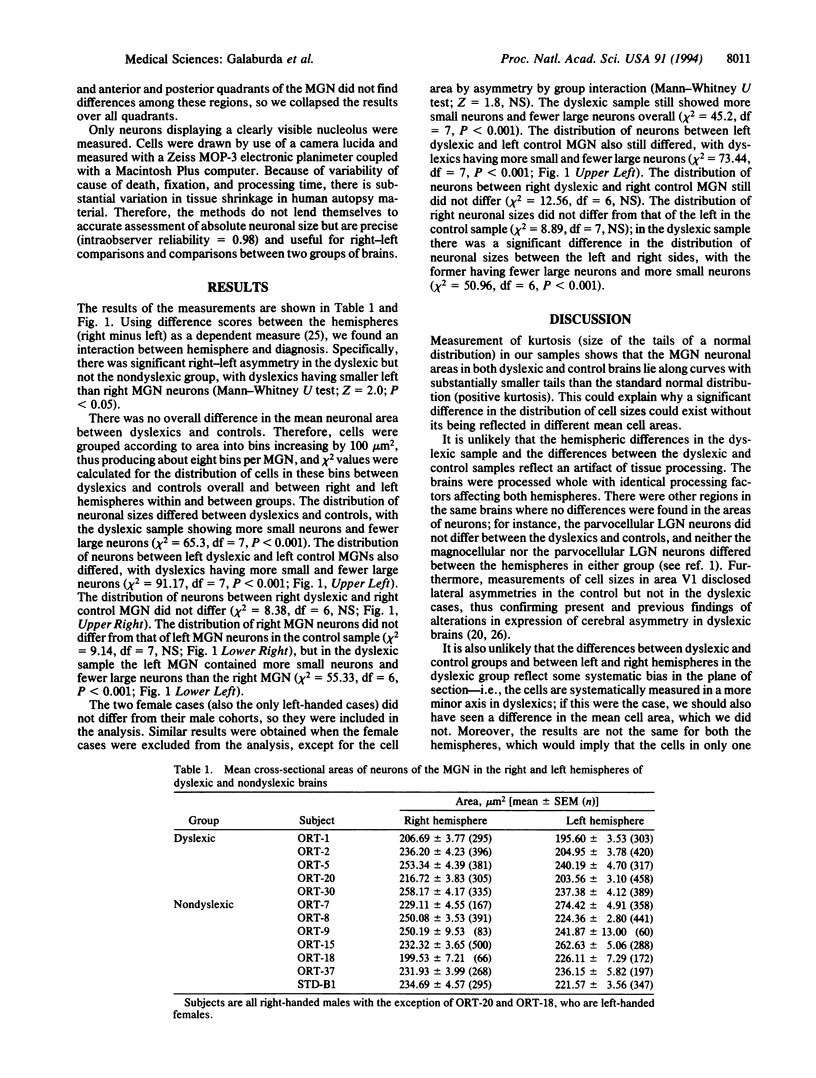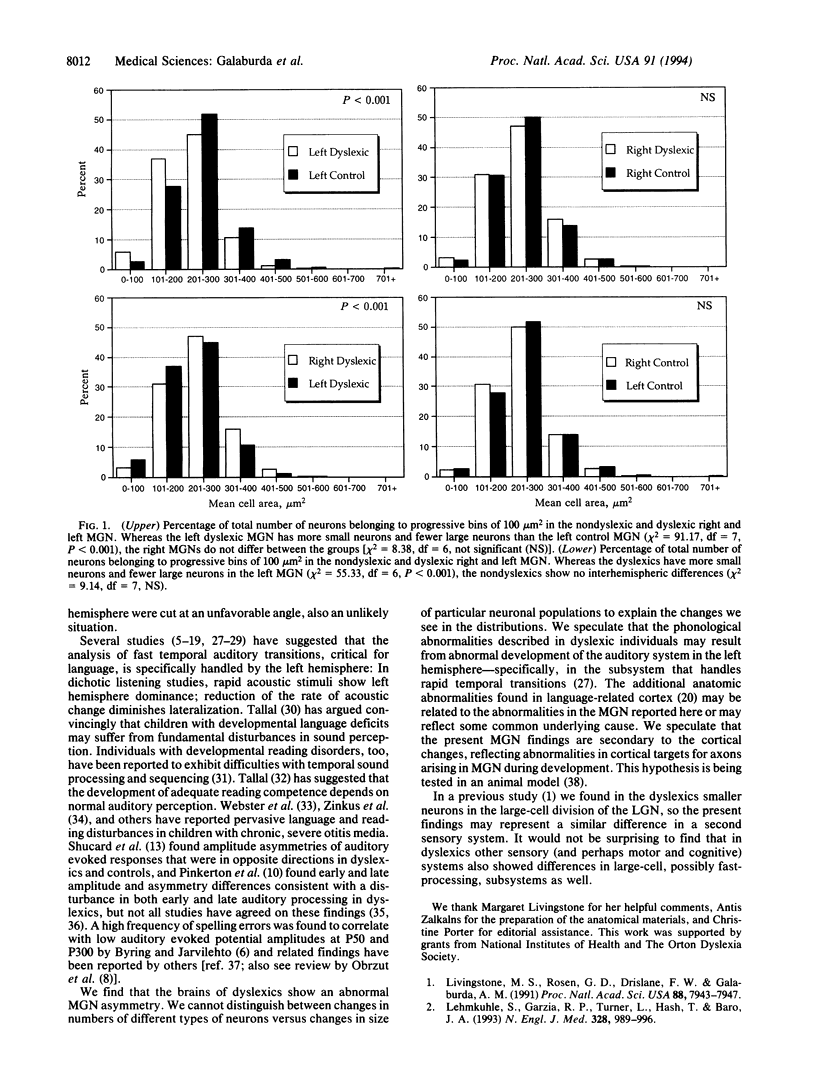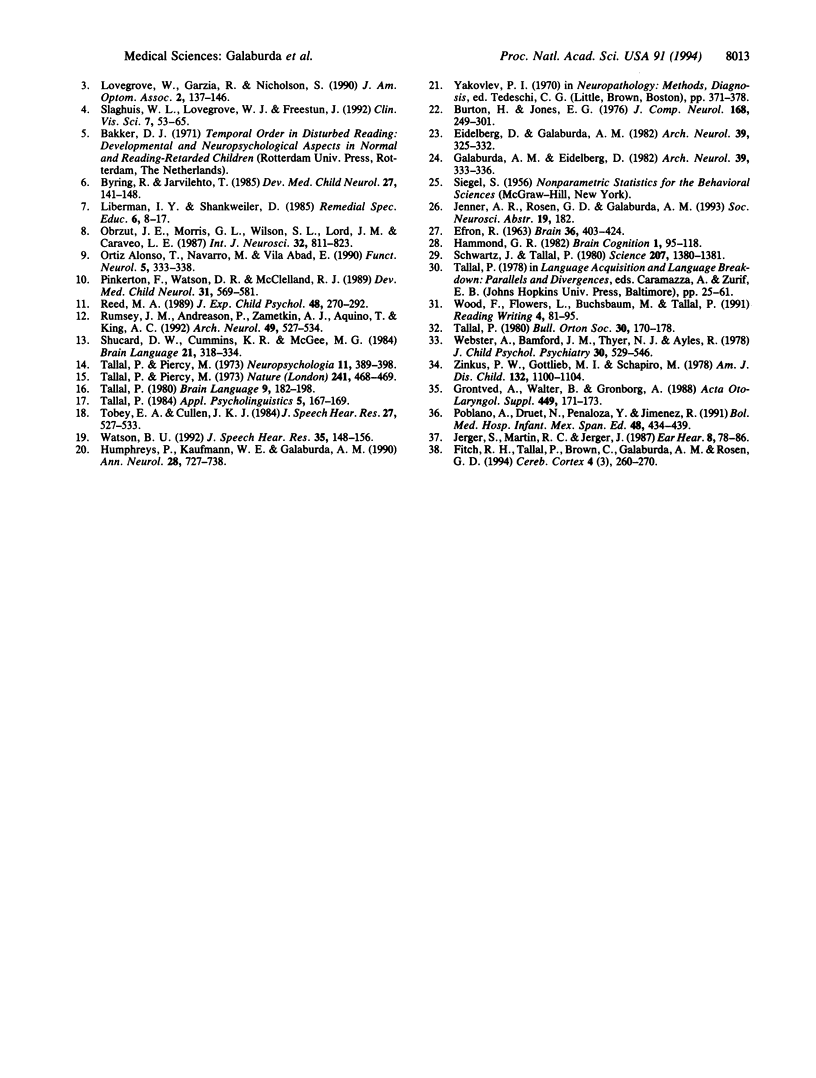Abstract
Abnormal auditory processing in dyslexics suggests that accompanying anatomical abnormalities might be present in the auditory system. Therefore, we measured cross-sectional neuronal areas in the medial geniculate nuclei (MGNs) of five dyslexic and seven control brains. In contrast to controls, which showed no asymmetry, the left-side MGN neurons were significantly smaller than the right in the dyslexic sample. Also, as compared with controls, there were more small neurons and fewer large neurons in the left dyslexic MGN. These findings are consistent with reported behavioral findings of a left hemisphere-based phonological defect in dyslexic individuals.
Full text
PDF



Selected References
These references are in PubMed. This may not be the complete list of references from this article.
- Burton H., Jones E. G. The posterior thalamic region and its cortical projection in New World and Old World monkeys. J Comp Neurol. 1976 Jul 15;168(2):249–301. doi: 10.1002/cne.901680204. [DOI] [PubMed] [Google Scholar]
- Byring R., Järvilehto T. Auditory and visual evoked potentials of schoolboys with spelling disabilities. Dev Med Child Neurol. 1985 Apr;27(2):141–148. doi: 10.1111/j.1469-8749.1985.tb03762.x. [DOI] [PubMed] [Google Scholar]
- Eidelberg D., Galaburda A. M. Symmetry and asymmetry in the human posterior thalamus. I. Cytoarchitectonic analysis in normal persons. Arch Neurol. 1982 Jun;39(6):325–332. doi: 10.1001/archneur.1982.00510180003001. [DOI] [PubMed] [Google Scholar]
- Fitch R. H., Tallal P., Brown C. P., Galaburda A. M., Rosen G. D. Induced microgyria and auditory temporal processing in rats: a model for language impairment? Cereb Cortex. 1994 May-Jun;4(3):260–270. doi: 10.1093/cercor/4.3.260. [DOI] [PubMed] [Google Scholar]
- Galaburda A. M., Eidelberg D. Symmetry and asymmetry in the human posterior thalamus. II. Thalamic lesions in a case of developmental dyslexia. Arch Neurol. 1982 Jun;39(6):333–336. doi: 10.1001/archneur.1982.00510180011002. [DOI] [PubMed] [Google Scholar]
- Grøntved A., Walter B., Grønborg A. Normal ABR's in dyslexic children. Acta Otolaryngol Suppl. 1988;449:171–173. doi: 10.3109/00016488809106404. [DOI] [PubMed] [Google Scholar]
- Hammond G. R. Hemispheric differences in temporal resolution. Brain Cogn. 1982 Jan;1(1):95–118. doi: 10.1016/0278-2626(82)90009-4. [DOI] [PubMed] [Google Scholar]
- Humphreys P., Kaufmann W. E., Galaburda A. M. Developmental dyslexia in women: neuropathological findings in three patients. Ann Neurol. 1990 Dec;28(6):727–738. doi: 10.1002/ana.410280602. [DOI] [PubMed] [Google Scholar]
- Jerger S., Martin R. C., Jerger J. Specific auditory perceptual dysfunction in a learning disabled child. Ear Hear. 1987 Apr;8(2):78–86. doi: 10.1097/00003446-198704000-00004. [DOI] [PubMed] [Google Scholar]
- Lehmkuhle S., Garzia R. P., Turner L., Hash T., Baro J. A. A defective visual pathway in children with reading disability. N Engl J Med. 1993 Apr 8;328(14):989–996. doi: 10.1056/NEJM199304083281402. [DOI] [PubMed] [Google Scholar]
- Livingstone M. S., Rosen G. D., Drislane F. W., Galaburda A. M. Physiological and anatomical evidence for a magnocellular defect in developmental dyslexia. Proc Natl Acad Sci U S A. 1991 Sep 15;88(18):7943–7947. doi: 10.1073/pnas.88.18.7943. [DOI] [PMC free article] [PubMed] [Google Scholar]
- Lovegrove W. J., Garzia R. P., Nicholson S. B. Experimental evidence for a transient system deficit in specific reading disability. J Am Optom Assoc. 1990 Feb;61(2):137–146. [PubMed] [Google Scholar]
- Obrzut J. E., Morris G. L., Wilson S. L., Lord J. M., Caraveo L. E. Brain stem evoked response in the assessment of learning disabilities. Int J Neurosci. 1987 Feb;32(3-4):811–823. doi: 10.3109/00207458709043335. [DOI] [PubMed] [Google Scholar]
- Ortiz Alonso T., Navarro M., Vila Abad E. P300 component of the auditory event-related potentials and dyslexia. Funct Neurol. 1990 Oct-Dec;5(4):333–338. [PubMed] [Google Scholar]
- Pinkerton F., Watson D. R., McClelland R. J. A neurophysiological study of children with reading, writing and spelling difficulties. Dev Med Child Neurol. 1989 Oct;31(5):569–581. doi: 10.1111/j.1469-8749.1989.tb04042.x. [DOI] [PubMed] [Google Scholar]
- Poblano A., Druet N., Peñaloza Y., Jiménez R. Potenciales provocados auditivamente del tallo cerebral y de latencia media en disléxicos y controles. Bol Med Hosp Infant Mex. 1991 Jun;48(6):434–439. [PubMed] [Google Scholar]
- Reed M. A. Speech perception and the discrimination of brief auditory cues in reading disabled children. J Exp Child Psychol. 1989 Oct;48(2):270–292. doi: 10.1016/0022-0965(89)90006-4. [DOI] [PubMed] [Google Scholar]
- Rumsey J. M., Andreason P., Zametkin A. J., Aquino T., King A. C., Hamburger S. D., Pikus A., Rapoport J. L., Cohen R. M. Failure to activate the left temporoparietal cortex in dyslexia. An oxygen 15 positron emission tomographic study. Arch Neurol. 1992 May;49(5):527–534. doi: 10.1001/archneur.1992.00530290115020. [DOI] [PubMed] [Google Scholar]
- Schwartz J., Tallal P. Rate of acoustic change may underlie hemispheric specialization for speech perception. Science. 1980 Mar 21;207(4437):1380–1381. doi: 10.1126/science.7355297. [DOI] [PubMed] [Google Scholar]
- Shucard D. W., Cummins K. R., McGee M. G. Event-related brain potentials differentiate normal and disabled readers. Brain Lang. 1984 Mar;21(2):318–334. doi: 10.1016/0093-934x(84)90055-5. [DOI] [PubMed] [Google Scholar]
- Tallal P. Auditory temporal perception, phonics, and reading disabilities in children. Brain Lang. 1980 Mar;9(2):182–198. doi: 10.1016/0093-934x(80)90139-x. [DOI] [PubMed] [Google Scholar]
- Tallal P., Piercy M. Defects of non-verbal auditory perception in children with developmental aphasia. Nature. 1973 Feb 16;241(5390):468–469. doi: 10.1038/241468a0. [DOI] [PubMed] [Google Scholar]
- Tallal P., Piercy M. Developmental aphasia: impaired rate of non-verbal processing as a function of sensory modality. Neuropsychologia. 1973 Oct;11(4):389–398. doi: 10.1016/0028-3932(73)90025-0. [DOI] [PubMed] [Google Scholar]
- Tallal P., Townsend J., Curtiss S., Wulfeck B. Phenotypic profiles of language-impaired children based on genetic/family history. Brain Lang. 1991 Jul;41(1):81–95. doi: 10.1016/0093-934x(91)90112-e. [DOI] [PubMed] [Google Scholar]
- Tobey E. A., Cullen J. K., Jr Temporal integration of tone glides by children with auditory-memory and reading problems. J Speech Hear Res. 1984 Dec;27(4):527–533. doi: 10.1044/jshr.2704.527. [DOI] [PubMed] [Google Scholar]
- Watson B. U. Auditory temporal acuity in normally achieving and learning-disabled college students. J Speech Hear Res. 1992 Feb;35(1):148–156. doi: 10.1044/jshr.3501.148. [DOI] [PubMed] [Google Scholar]
- Webster A., Bamford J. M., Thyer N. J., Ayles R. The psychological, educational and auditory sequelae of early, persistent secretory otitis media. J Child Psychol Psychiatry. 1989 Jul;30(4):529–546. doi: 10.1111/j.1469-7610.1989.tb00266.x. [DOI] [PubMed] [Google Scholar]
- Zinkus P. W., Gottlieb M. I., Schapiro M. Developmental and psychoeducational sequelae of chronic otitis media. Am J Dis Child. 1978 Nov;132(11):1100–1104. doi: 10.1001/archpedi.1978.02120360056010. [DOI] [PubMed] [Google Scholar]


